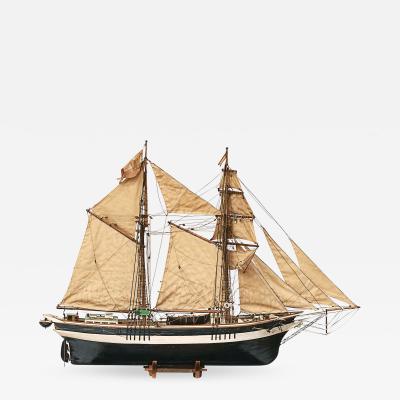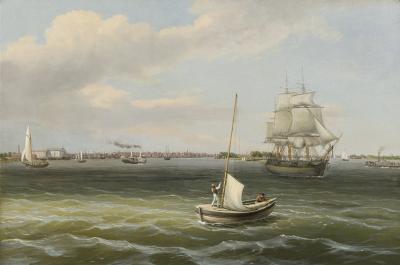Collectors Bebe and Crosby Kemper
When pressed to choose a favorite artist, R. Crosby Kemper, Jr. (known to friends as Crosby) names Thomas Hart Benton. And that answer befits the collector. Crosby, chairman of UMB Financial Corporation, and Benton, known as a painter of folklore and everyday life in the 1910s to 1930s, are two Kansas City natives inextricably linked to the Plains region. The benevolent banker is regarded for the success of his family-run multibank holding company and for his significant art collection and charitable giving. Understandably, Crosby relates to Benton’s enduring renditions of America’s heartland. The two men shared a warm friendship and the multidimensional bond of patron and artist; they even vacationed together on the isle of Martha’s Vineyard. Crosby ultimately collected several works by Benton and, after the artist’s death, his bank became the coexecutor and cotrustee of Benton’s estate.
However, he hesitates to single out Benton, because throughout the creation of his vast art collection, Crosby has shared memorable experiences with many artists and dealers. He is also rewarded with a collecting partnership with his painter wife, Bebe Stripp, enriched by her advantageous artist’s eye. Together they have formed close associations with some of America’s leading contemporary artists—from the Wyeths to glass artist Dale Chihuly. The couple has developed important personal, corporate, and museum collections, each containing works by modern and living artists such as Jackson Pollack, Frank Stella, and Helen Frankenthaler. An historical survey of art is also represented with paintings by Fragonard, Monet, Church, Lane, Hassam, Homer, Sargent, and many others.
Crosby has served as a commissioner of the National Museum of American Art, and both Kempers have been involved as trustees on several art institution boards including the Whitney Museum National Committee, the Addison Gallery at Phillips Academy in Andover, Massachusetts, the Nelson-Atkins Museum of Art, and the Kemper Museum of Contemporary Art. The couple purchases works specifically for these museum collections and others. They also deaccession paintings from their personal collection as gifts to institutions.
Five decades of collecting undoubtedly involves many interesting tales. Once on a trip to the South with daughter Sheila, Crosby discovered the now-infamous Savannah, Georgia, dealer James Williams, who “had an uncanny ability to ferret out fine portraits.” On a later visit, the high-spirited Williams invited Crosby to his third-floor salon for martinis and a game of craps. He tempted the collector with a John Singer Sargent study for a figure in the Boston Library’s mural if he won. Although an inexperienced gambler, Crosby accepted the challenge and, in a stroke of luck, drove home with the Sargent. Alas, on the retelling of his story to Bebe, he was urged to return the painting, now estimated to be worth $400,000. “She apparently didn’t think it right to gamble for paintings,” he says.
Years later, Bebe gave Crosby a copy of the best-selling murder-mystery Midnight in the Garden of Good and Evil for its descriptive Savannah setting. Little did she realize that its homicidal main character was based on Williams (who was acquitted for the crime of killing his apprentice).
Other Sargent paintings have come the Kempers’ way and have been added to their personal collection and gifted to museums. When Mrs. Cecil Wade appeared at auction years ago, Nicholas Hall, then of the London firm Colnaghi, purchased the painting for the Kempers at $1.275 million, now a seeming bargain compared to the recent auction record of $11 million for Sargent’s work. Mrs. Cecil Wade was Sargent’s first commissioned work in London after the Madame X scandal caused him to leave France. Hall, now of Hall and Knight in New York, continues to develop the Kempers’ collection. He once spotted a miscatalogued Rubens at auction for the couple. Hall also sold them a few charming portraits of children by French artists Corot and Elizabeth-Louise Vigée LeBrun.
Crosby’s involvement with art and sharing that passion with his family is the very highpoint of his life. So when one of his seven children, Heather, opted to visit Tiffany’s and Kennedy Galleries in lieu of a soujourn to the toy store FAO Schwartz, the proposal was not refused for the 12-year-old’s birthday trip to New York. At Kennedy’s, Lawrence Fleischman presented several works that Crosby decided to purchase for the Albrecht Museum (now renamed the Albrecht-Kemper Musuem in honor of his contributions). Before the transaction was fully negotiated, young Heather piped in, “If you throw in the Hopper, we’ll make a deal.” Startled, Fleischman eventually agreed to include the Truro, Cape Cod, watercolor in the group for the museum.
Hopper’s Cape Cod is a familiar scene to the family. During summer vacations at their casual home on an ocean bluff in Chatham, Massachusetts, they relax, gather with friends and family, play tennis, and sail. The seaside residence features a collection of majolica and folk artist Ralph Cahoon’s cavorting mermaids painted on captains chests. Of course, the walls are covered with contemporary and Cape Cod paintings including a lively John Whorf watercolor of a moonlit beach dance, reminiscent of Winslow Homer.
The museum’s collection continues to grow from their efforts to support living artists. It also includes modern works by twentieth-century “greats”—from the impressions of Childe Hassam to the abstractions of Willem de Kooning.
Dale Chihuly’s work, now exhibited throughout the Kemper Museum and the UMB Bank, was recommended by son Mariner, who saw his work while a college student near the glass artist’s home base of Seattle. In 1996 the Kempers underwrote the extraordinary exhibition Chihuly Over Venice, which was installed over Venetian canals. The outcome of the sponsorship resulted in a “fabulous deal” of three Chihuly creations being donated to the Kemper Museum.
Over the years, dealers have alerted the Kempers to many attractive collecting opportunities as well as a few not-so-fabulous directives. Martha Parrish, formerly of Hirschl & Adler (now in her own firm with Jim Reinish), sold the Kempers several Fairfield Porters right after the artist’s death, for excellent prices. Crosby was also able to acquire Edward Hopper’s largest painting, Intermission, admired on a visit to Hirschl & Adler. The work was later sold through Parrish to a very persistent investment banker for four times what Crosby had paid. At other times, the collector’s purchases have languished in basements. A museum director once persuaded him to buy the work of contemporary realist John Clem Clarke, an artist whom Crosby wryly notes as having yet to be “rediscovered.”
A still life by Wayne Thiebaud, whose work the Kempers collected before he was well known, was included in the exhibition The Collector as Patron in the Twentieth Century, organized by the Frick Art Collection and Knoedler & Company in 2000. The early-twentieth-century tastemakers Mellon, Frick, Morgan, Phillips, and the Clarks were featured along with four collectors of the late twentieth century, including the Kempers. As The New York Observer critic Hilton Kramer remarked, “The Kempers set out to create a museum of contemporary art in Kansas City, MO., and on the basis of what we see in this exhibition—excellent examples of Romare Beardon, Helen Frankenthaler, Franz Kline, Robert Motherwell, Fairfield Porter, and Wayne Thiebaud—we would have to conclude that they have amply succeeded in that endeavor. Theirs is the only collection here that one is eager to see more of.”
The critic’s wish may come true. The Kempers recently vacated their empty nest and downsized the contents of a large English Tudor–style mansion into a manageable Kansas City apartment. Thus more astounding works from their personal collection are en route to museums. “I do not feel that I possess art, but am merely the caretaker for another collector or museum,” explains Crosby.
The critic’s wish may come true. The Kempers recently vacated their empty nest and downsized the contents of a large English Tudor–style mansion into a manageable Kansas City apartment. Thus more astounding works from their personal collection are en route to museums. “I do not feel that I possess art, but am merely the caretaker for another collector or museum,” explains Crosby.
However, some of their “keepers” are works by Andrew Wyeth. Many years ago the Kempers gave Andrew’s Battleground and Thin Is Vanity to the Nelson-Atkins, but they’ve kept his moving portrait of sister Ann and a lighthouse watercolor titled Sailor’s Valentine. They avidly collect both Andrew’s and his son Jamie’s work, and value a long-standing relationship with the family.
On visits to see the artist-family in Maine, the Kempers have dined at the Olsen homestead, now a museum. (Christina Olsen, the Wyeths’ neighbor, posed for Andrew’s famous painting Christina’s World). And the Kempers discovered the Wyeth clans’ macabre sense of humor when they were led to picnic among the headstones of the Olsen family graveyard.
“The fun of collecting is in the storytelling,” maintains Crosby. Yet his reasons for collecting are both simple and serious, one being the pure pleasure that art gives. He refers to a New York Times article that outlined the three reasons people collect—status, acquisitiveness, and investment— and says, “I don’t fit into any of those motivations— my joy is to live in a beautiful environment.” Second is the lasting legacy of giving art to museums for the public’s enjoyment. Crosby believes that “the future of civilized life is enhanced by the good influence we have on other people and in the arts; all else is immaterial.”
This article was based on interviews with Crosby and Bebe Kemper as well as R. Crosby Kemper’s self-published book Banking on Art: Fifty Years of Collecting (2000), available through the Kemper Museum bookstore, 816.753.5784. I am also grateful to Tonya Wetzel of UMB Bank, Jennifer Nauss of the Nelson-Atkins, Dawn Giegerich and Margaret Keogh of the Kemper Museum, and Bill and Terry Vose of Vose Galleries of Boston.















.gif)
.jpg)
.jpg)
.jpg)
.jpg)
.jpg)
.jpg)
.jpg)
.jpg)
.jpg)
.jpg)

















